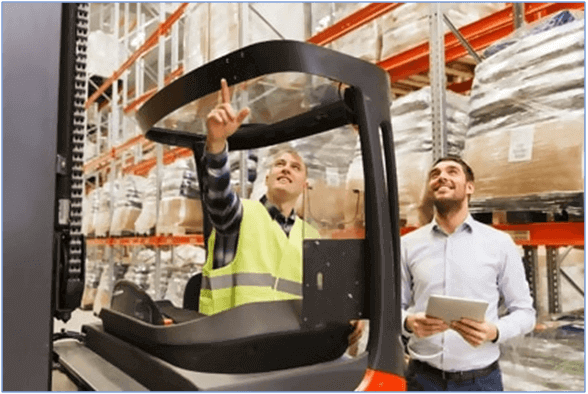A smart warehouse is the culmination of warehouse automation. In other words, automating various components of your warehousing operations. Like a smart home, a smart warehouse is enabled with several automated and interconnected technologies. These technologies work together to increase the productivity and efficiency of the warehouse, minimizing the number of human workers while decreasing errors.
As Royce Digital explains, “In manual warehouses, we usually saw workers moving around with lists, picking products, loading them into carts and then delivering them to the shipping docks,” but in smart warehousing, “Orders are received automatically, after which the system confirms if the products are in stock. The pick-up lists are then sent to robot-carts that place the ordered products into containers and deliver them to workers for the next step”.

Table of Contents
A Smart Warehouse
Ostensibly, the world of smart warehousing can be a difficult one to navigate, especially once you take the time to consider on the rate with which new products are being introduced to the market. This article discusses the most popular products and processes that are essential for smart warehouse technologies.
1. Automated Picking Tools
2. Automatic Guided Vehicles (AGVs)
3. Automated Inventory Control Platforms
4. Warehouse Management Systems
5. Internet of Things (IoT) Implementation
6. Collaborative Robots (Cobots)
7. Automated Storage and Retrieval Systems (AS/RS)
Some of these technologies you may have heard of whilst some of which you may have not.
Automated Picking Tools
Long gone are the days of the error-riddled picking; now, warehouses can benefit from near-perfect picking rates when picking automation elements are integrated into the flow. There are a few varieties of different tools that can be used to boost picking procedures, such as the voice automated order picking, robotic order picking, and pick-to-light. These technologies can also make use of cutting-edge barcoding options that integrate seamlessly with your chosen management software for the fastest, most accurate automated reporting experiences.
Automatic Guided Vehicles (AGVs)
There’s no better way to ramp up your storage and retrieval processes than to integrate automatic guided vehicles, otherwise known as AGVs, into your warehouse. The structural integrity of AGVs are evolving as the technology moves forward, but even the models that have been on the market for some time have proven to be safer and yield a quicker ROI than the manual labor. Some of their most important functions include pallet, rack, and other container storage, and even functions that control and automate the whole entire receiving process.
Automated Inventory Control Platforms
When used in conjunction with a handful of other technological mainstays, such as asset and inventory tags, automated inventory control platforms are implemented to take the labor, guesswork, and extraneous time out of traditional inventory control. To sweeten the deal, most of these platforms are built to automatically count the inventory and synthesize the data for fast, real-time, and ultra-accurate reporting that can be accessed remotely.
Warehouse Management Systems
Warehouse Management Systems, otherwise known as WMSs, are comprehensive software systems that wrangle all your important data into one platform that can be easily accessed by internal players as well as any chosen members of your supply chain. This compartmentalizing of data makes for lightning-fast reporting which, when used tactfully, can mean uber-efficient planning, even for the scenarios that you didn’t see coming. All in all, the use of warehouse management – or warehouse execution – systems perfectly complements other automated elements.
Internet of Things (IoT) Implementation
You may have seen commercials and also online advertising for everything from predictive maintenance to home automation using IoT. It is a simple, largely intuitive concept that is helping to digitally transform the supply chain and the way that consumers live. From home automation in smart homes to smart cities and DDOS attacks, IoT is in the news frequently these days.
The Internet of Things, or IoT, is more of an overarching concept than an individual technology, but it is regularly put into place in the world’s most effective smart warehouses. When IoT is utilized to control a plethora of moving parts, both the automated and manual, it can optimize all of your processes so that their data lives in one, easy-to-access network. This helps us to optimize a warehouse’s inventory control procedures, labor planning, and, of course, its overall customer experience through more rapid fulfillment rates.

Collaborative Robots (Cobots)
A cobot, or “collaborative robot” is specially designed to ease human-machine interface and enhance security. These machines also can work with human workers in the same areas and manage risks thanks to their sensitivity and also the programming.
The full content is only visible to SIPMM members
Already a member? Please Login to continue reading.
References
Ann Chong Fong Ting, DPSM. (2018). “Warehouse Technologies for Effective Inventory Control”. Retrieved from SIPMM: https://publication.sipmm.edu.sg/warehouse-technologies-effective-inventory-control, accessed 15/03/2019.
Datex. (2019). “IoT and the Smart Warehouse”. Retrieved from https://www.datexcorp.com/iot-and-the-smart-warehouse, accessed 15/03/2019.
Helmi Salleh, ADLSM. (2019). “Autonomous Devices For Digital Warehousing”. Retrieved from SIPMM: https://publication.sipmm.edu.sg/autonomous-devices-digital-warehousing, accessed 15/03/2019.
SelectHub. (2019). “What are Smart Warehouse System”. Retrieved from https://selecthub.com/warehouse-management/smart-warehouse-systems, accessed 15/03/2019.
Shelly Stazzone. (2019). “7 Smart Warehouse Technologies”. Retrieved from https://www.camcode.com/asset-tags/smart-warehouse-technologies, accessed 15/03/2019.
The Future Warehouse. (2019). “Cobots – Collaborative Robots”. Retrieved from https://www.thefuturewarehouse.com/cobots, accessed 15/03/2019.

